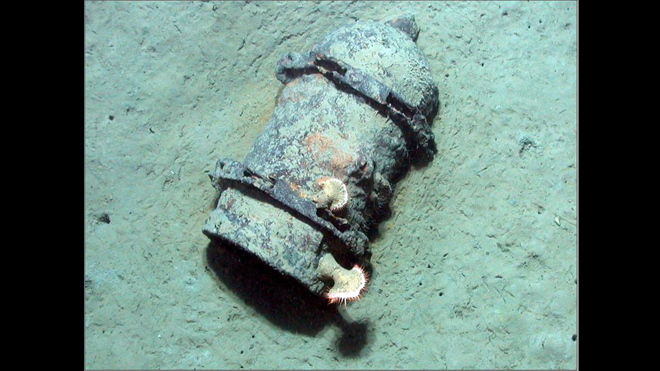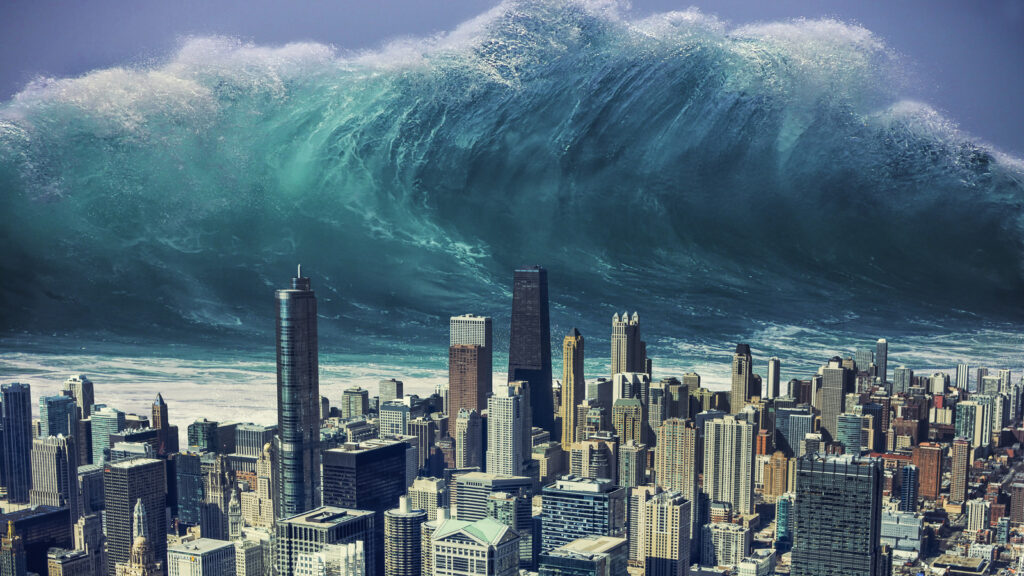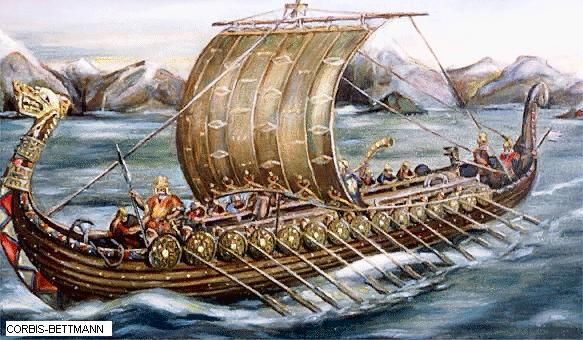Years ago I attended an economics seminar where the prof happened to note that three tons of gold are dissolved in every cubic mile of seawater. This excited some until we saw that a cubic mile is 1.1 trillion gallons. Even if a plant could process a million gallons of seawater a day to extract the gold, it would take just over 3000 years to process a cubic mile. If those are Troy-weight “tons” (12 ounces per pound, 31.1 grams per ounce), the yield would be just 24 Troy ounces of gold per year – i.e., about $45,000 at the current world price. Not exactly a prospecting fortune. In fact, the entire three tons of gold would be worth around $136 million at today’s price.
If these numbers don’t impress you, consider the size of the ocean – 1.37 billion cubic kilometers. This works out to 328,496,117 cubic miles, or 362,579,596,800,000,000,000 gallons (i.e., 362 quintillion, 579 quadrillion, 596 trillion, 800 billion). A million plants, each pumping a million gallons of water per day, would take 993,369 years to process the whole ocean. (Not bad, but staff continuity and parts might be a problem.)
Even though I’m a numbers guy, these numbers are too much. I can write them and correctly say their names, but for a number to be graspable it has to relate to what we know. Something six feet long is about the height of the average American man. A hundred yards is a football field. We know what a gallon is, and maybe what twenty gallons is (an average-sized trash can). A dump truck holds a couple tons of dirt. But we really can’t grasp a million gallons, let alone a trillion, quadrillion or quintillion. Knowing the number doesn’t inform us about the vastness of the quantity. This presents a problem when people talk about the ocean and the atmosphere.
Over the last half-century, environmentalists have pushed hard to stop ocean-pollution. This is a good thing. Certainly we should minimize debris and pollutants thrown into the oceans. But to put it in perspective – man has been putting junk and garbage and bodies in the oceans for millennia without discernible effect. We would be amazed at what has been dumped there. Look up “ocean mustard gas” on Yahoo if you want a real shock. Whole trainloads of poison gas went into the sea after World Wars I and II. Despite our stupidity about such things, the ocean’s size protects us. Even huge quantities of poisons are trivial within 362 quintillion gallons.

I say this not to justify or condone ocean pollution. Far from it. I merely cite the mind-boggling size of the ocean to put pollution in perspective. When we’re afraid to pump oil out of the sea bed because we might accidentally spill some, we’re not really aware of how big the ocean is. We’re scaring ourselves away from resources we need because of ignorance.
The ocean’s size is also helpful for grasping the size of the atmosphere. The ocean covers about 75% of the globe’s surface. It is no more than 7 miles deep anywhere, and considerably less in most places. The atmosphere covers the entire globe and is a radial layer (like an orange peel) above the earth. The troposphere is about seven miles thick, and the lower stratosphere goes to about 15 miles. There isn’t much air at 15 miles, and not even very much at 10, but for our purposes we’ll say our atmosphere is 10 miles thick. A 10-miles atmosphere is 2.015 billion cubic miles, or 2,225,244,799,038,090,000,000 gallons. (That’s 2.225 sextillion gallons, or 8.42 sextillion liters – about seven times the ocean’s size.)
Air – the gas which occupies the atmosphere – is a mixture of oxygen (78%), nitrogen (21%), argon (0.9%), and carbon dioxide (0.034%), plus water vapor and other trace substances. The amount of air in the atmosphere can be calculated from the known fact that the weight of air on a square inch of the earth is 14.7 pounds (i.e., “air pressure” at sea-level.) Since the radius of the earth is 6360 km (i.e., 250,393,701 inches), the earth’s surface-area is 787,873,140,703,081,000 (787.9 quadrillion) square inches. Every square inch bears the weight of 14.7 pounds of air above it, so the atmosphere’s apparent weight is 5,790,867,584,167,650 (5.8 quadrillion) tons.
I present these calculations (with apologies for the mind-boggling numbers) about the sea and atmosphere to help readers not to be misled by politicians crying doom. Yes, dumping in the ocean is undesirable, but it’s important to calibrate quantities against the size of the sea. When we hear that a million gallons of oil have been spilled, it sounds disastrous (and it’s certainly not good), but we need to recall the 363 quintillion gallons (i.e., 362,579,596,800,000,000,000). A million gallons is a lot if it’s dumped on you, but in the ocean it’s a figurative drop in the bucket – just the last 6 of those 21 digits in 362 quintillion.
Also, we need to recall that the ocean is not just gentle waves tickling baby’s feet at Ocean City. It is a vast mixing bowl of unimaginable power – utterly uncontrollable and capable of destroying almost any of man’s inventions. No oil company wants to spill oil in the ocean, but all marine life will not die if it happens. Millions upon millions of gallons of oil sank into the sea during World Wars I & II. Where is it now? Emulsified to microscopic-sized particles by the sea’s tireless motion. That motion protects the sea from the privations of man.

Similarly, we should calibrate scare-talk about CO2 emissions to the atmosphere’s size and the amount of CO2 already in it. 0.034% of the atmosphere (by weight) equals 1,968,894,978,617 (nearly 2 trillion) tons of CO2. Current estimates put global discharges at 6 billion tons of CO2 per year. This isn’t nothing, but it’s only 0.3% of the current amount of CO2 in the atmosphere. At this rate, it would take 230 years to double the atmosphere’s CO2. But we have not measured natural processes long enough to know whether the ecosystem would “permit” a doubling of CO2, or whether a natural effect (like increased plant life) would reduce it. This might have happened in the past when volcanic or meteoric events spewed huge quantities of CO2 and particulate matter into the air.
No one thought much about these things until we hit a warm period in recent years. Although pundits in the late 1970s thought we were heading for a “new ice age” – with bitterly cold temperatures and the Potomac River frozen over – they soon went the other way as Al Gore and others started scare-mongering about the climate being warmed by “greenhouse gas” (i.e., CO2) emissions. Scientifically ignorant reporters picked up the theme because they are drawn to conflict. Mr. Gore declared the science “settled” on global warming, but he is talking through his hat. Scientists don’t even agree that we were in a warming period, let alone what was causing it.
Other warm eras have occurred in recorded history, including the Medieval Warming Period (ca. A.D. 900-1300), when Europeans left their smoky huts to build cathedrals. Vikings rowed around the North Atlantic in open boats (have you ever thought about that?) and settled Greenland. When I was a boy, historians were still chortling over Viking real estate “shysters” who lured gullible Norwegians and Danes to Greenland, which (historians said) was just a frozen wasteland. But archaeologists have found evidence of farms and vineyards from that era in Southern Greenland. The Northern Hemisphere was warmer then, with no factories or SUVs “causing” it. Something else was at work in the climate, and might have been at work at other times. We don’t understand it, but this doesn’t mean we should pretend that other warm periods didn’t happen or that our time is uniquely perilous.
170 years ago some scientists believed that organs like the eye evolved over eons of time, because they didn’t understand its complexity. As scientists now recognize that the eye is “irreducibly complex,” and could not have evolved in steps, many are distancing themselves from Darwin’s theory. The “evidence” Darwin expected to emerge from the fossil record has not been found, despite exhaustive – some would say “desperate” – research. We know a lot more than in the 1850s, so scientists who have not hitched their careers to evolution are backing away from it.
Just so, our ignorance of the vast dynamics and the incomprehensible size of both the sea and the atmosphere has allowed political shills to scare us to death. We are actually on the point of letting politicians crash the world economy to keep us from frying (or freezing) ourselves – although scientists do not agree that there is truly a problem, or that we can do a thing about it, if there is. Knowing the size of the seas and the atmosphere will hopefully help an informed citizenry to laugh these charlatans off the stage. The world didn’t end in 1000, when Vikings farmed and pressed wine in Greenland, and it’s not going to end now.


